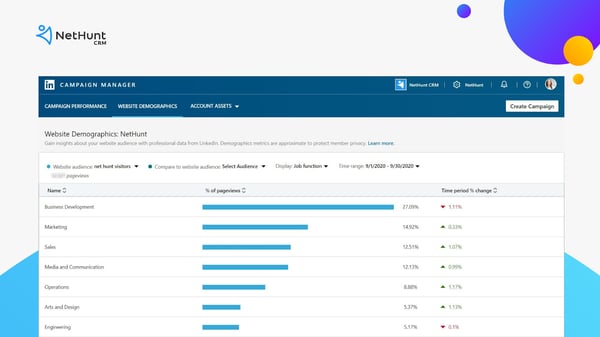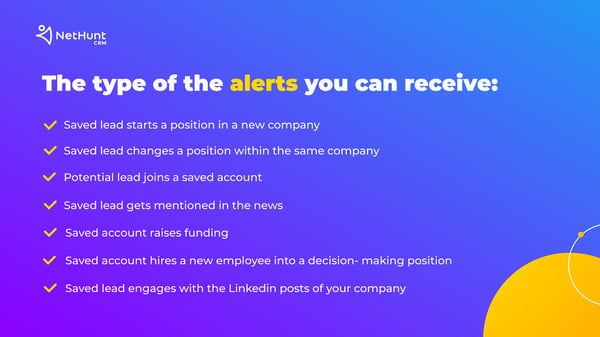November 7, 2023
 by George Rowlands / November 7, 2023
by George Rowlands / November 7, 2023

LinkedIn has proven to be the most powerful social media for business people and salespeople.
Four out of five people on LinkedIn "drive business decisions," which makes it perfect for acquiring customers. B2B sales are easy on LinkedIn, especially if you know the right place to look and have the right strategy to pursue.
The social traction received from published posts, content, or advertisements is measured with social media analytics platforms. It targets demographics, audience reactions, and segments and stores it into an actionable report. This report can be barnacled to future lead nurturing or product marketing campaigns to hit the audience's intent.
LinkedIn analytics is a powerful tool that allows you to track and assess the performance of your page on LinkedIn. You can use it for your personal and business pages, depending on the level of detail you expect to see (business page analytics tend to be more in-depth). While used across departments, it brings the most benefits to the sales and marketing teams as it provides them with actionable insights.
There are plenty of different metrics accessible to business owners as a part of their LinkedIn analytics dashboard. The campaign monitoring tool, which allows you to view lead influx, retention metrics, click, open, and acquisition reports, is also known as the LinkedIn Campaign Management tool.
Broadly, all of them can be divided into three categories, as noted by Hootsuite:
Depending on the end goal of your analysis, you can focus on tracking one or several metrics, compare and contrast them, or export them into dedicated software for further manipulations.
LinkedIn is traditionally considered the most effective social media platform for professionals. It lets you get better acquainted with your industry, expand your network, and stay up-to-date with the latest trends.
LinkedIn analytics is a glorified version of Facebook analytics – only professional. Its users share opinions, comment on each other’s posts, and react to life updates with likes, reactions, and thumbs up. However, there’s a crucial difference between the two.
While Facebook users are simply trying to let the world know what they’re up to, LinkedIn users are all united by the same endeavor: to prompt their career’s rapid growth.
LinkedIn analytics is valuable for businesses and individuals. Stimulated by the desire to advance their career, LinkedIn analytics genuinely evaluates user interest. The app does not stall numbers or produce vanity metrics to feed false expectations of paid advertisers or campaign managers.
Getting access to the most up-to-date and relevant information about the industry’s key players, potential customers, and the rest of the target audience, all neatly organized in the form of a well-structured LinkedIn analytics dashboard, is something every salesperson can get behind. Indeed, LinkedIn provides enough functionality to extract plenty of data for sales. The question is how to use this data to accelerate the sales conversations.
The three most valuable activities LinkedIn can help you out with immensely are research and lead pre-qualification, industry monitoring, and prospecting.
One of the most crucial parts of the sales process is to qualify the lead. It's important to determine whether a prospect fits your ideal buyer persona, how likely they are to become a customer, and most importantly, whether they will retain for a long time and how high the chances of customer churn are. These are essential for estimating how much effort would be reasonable to nurture them.
Too often, the leads you obtain from your website must be more specific. Even if you encourage people to provide as much information upon registration as possible, there's only so much you can ask them about themselves without being creepy.
LinkedIn analytics is a great socially acceptable stalking tool. All the information you need for your improv research is your lead's first and last name or the name of their company.
LinkedIn analytics gives you access to a great deal of valuable information about your potential customers.
One quick LinkedIn search will help you provide answers to the following lead qualification questions:
However, you don't have to stop there. LinkedIn analytics has a lot to offer. For example, you can find the size of the company interested in your products and the sizes of the teams that can benefit from using them. Based on this data, you can easily estimate the price of the future deal.
On top of that, even surface-level LinkedIn digging can provide you with all the necessary information about the existing roles within your lead's company. This data will give you an understanding of which processes run in the organization. You can craft a personalized offer with the most suitable features to match your leads' needs.
Accurately pre-qualifying your leads through LinkedIn analytics allows you to conduct better-targeted demo calls and showcase the product functionality most suitable for your leads' workflows. All that combined implies a higher chance of closing the deal quicker!
One of the best things about LinkedIn analytics is its variety of options when gathering current information about the industry. There are several ways in which you can stay informed of all the things your drive is up to at the moment:
Some industries are more well-represented than others. The most popular industries among LinkedIn users are:
If your business operates in one of these, it’s almost guaranteed that LinkedIn will be extremely helpful in allowing you to monitor your industry. However, even if not, there are currently 148 different industries listed on LinkedIn, so you can definitely find the right crowd to join and observe.
LinkedIn is used to connect people within the industry-specific fraternity. You don’t have to click around to find prospects. Instead, you have highly effective tools and algorithms to help you get more options.
The greatest advantage of exploiting the graces of LinkedIn for prospecting is that you aren’t just cold prospecting. LinkedIn helps create a sense of familiarity and, therefore, warm your prospects up to you. The platform is perfect for networking and social selling, especially if you know the special tricks.
The best ways to use LinkedIn for prospecting include the following:
Alum network is the best strategy for those salespeople who attended large universities with many alumni. This method aims to connect with people you don’t know but have something in common. In the perfect scenario, the two of you should share more interests than just going to the same university, but even that alone is a good starting point.
Having common ground with someone instantly warms them up to you and makes them more inclined to listen to your words. It’s a great bonding point that can help you kickstart a conversation and move into the actual selling process.
With this feature, if somebody checks out your profile, it rubs off their intention. It automatically implies they’re interested in what you have to offer. While people in this section might not be the people you thought of targeting, they still can be a close match. It never hurts to give it a shot. If they operate in the same or adjacent industry, there’s a high chance of them being willing to learn more about your business and what you’re offering.
Whenever you find a prospect, there’s a chance the next one is just around the corner. You’re not the only one using LinkedIn analytics, and your competitors are likely looking for prospects, too. Please give them a big thanks because LinkedIn garners that information and suggests related profiles that fit the search sequence.
LinkedIn is famous for its users’ activity - they share ideas, publish posts, repost things they find interesting, and engage in numerous discussions. The best space for industry-specific talk is special groups.
LinkedIn groups have two options: join an existing one or create one yourself. While the latter sounds like it could give you much selling power, it’s too laborious. Growing a group and prompting people to join can distract you from actual prospecting. On the other hand, if you join someone else’s community that’s already full of active members, you can start selling socially.
LinkedIn analytics can sometimes be overwhelming due to the range of the data this tool provides. To get the most out of it, you need to know exactly what sales data you need to consider and how it can help you boost your sales.
Your brand is your face in the world of business. Therefore, you need to work hard to ensure your look is fresh, clean, and preferably well-groomed. You don’t want random incoherence to scare off your prospects and prevent you from making more sales.
Therefore, you need to work on keeping your branding in order. Luckily, LinkedIn offers its users a profile analytics tool for that. It allows you to measure your profile performance, track what’s hot and not, and learn more about the crowd you attract.
While the free analytics LinkedIn provides to individual members could be more detailed and in-depth, especially compared to advertising and business accounts, you can still gather plenty of valuable data. It would help you adjust your promotion as a sales expert.
You don’t have to reach out immediately, but it’s always wise to keep track of who might be interested in hearing more about your business and offers. The people who viewed your profile are the perfect targets for your next prospecting spree!
You can see which people engage the most with the content you share on your LinkedIn page. Both companies, titles, and geographical locations of the users interacting with your posts can be helpful when determining your audience. Perhaps there’s a spike of interest in your business in a region you haven’t viewed as a target region before? Or, maybe you’re underperforming in the area. There’s a reason for both of these situations, and LinkedIn helps you to spot a pattern as early as possible to determine the reasons for it.
Track top-performing posts to identify the most relevant topics and pain points resonating with your target audience. It allows better personalization of your offer and gives you additional ideas to implement into your content plan. Cover the topics with the most extensive engagement and create a positive feedback loop.
Most companies know LinkedIn analytics as a way to run and analyze the performance of ad campaigns. But it is much more than that.
LinkedIn analytics features several integrations, like insights pixels, website visitors, SEO metrics, and visitor information. LinkedIn analytics Insights lets you get professional demographic data about website visitors and which content they engage with the most. You add the LinkedIn Insights pixel into the code of your website, and it collects valuable data about your visitors: specific companies that visit your website, the industry that the company operates in, company, job titles, location, and more.

All of this information compiled can give you a better understanding of how to conduct adjacent business processes more efficiently, such as:
LinkedIn Sales Navigator is one of the most valuable integrations for LinkedIn. It’s aimed at expanding the circle of features accessible to users and giving them access to even more detailed statistics.
Several key features make LinkedIn Sales Navigator a significant investment, including access to more profile data, better prospecting and lead generation opportunities, and more. Of course, it improves the quality of LinkedIn analytics, too. The two most powerful features of LinkedIn Sales Navigator are News and insights and LinkedIn Sales Navigator alerts.
Based on sales preferences, salespeople can check on the latest industry news and potential leads to:
On top of that, LinkedIn Sales Navigator is irreplaceable if you’re trying to target a specific company and score a deal with them. It provides insights into particular categories: employee count, lead shares, account shares, and lead news. With this knowledge, you always know who to contact, how to personalize the offer to fit their needs, and how to actualize your product to secure a customer.
With LinkedIn Sales Navigator alerts, users receive real-time updates on accounts or prospects. This helps them apply a reactive approach to re-engage prospects or take the conversation to the next level.
LinkedIn Sales Navigator lets users customize the alerts they receive to their needs.

The way you use LinkedIn analytics can either make or break your business. The volume and quality of the sales you drive, especially if you’re a B2B company, depends on how well you can assess your performance to spot pitfalls and opportunities.
Thanks to the vast functionality of LinkedIn analytics, you can track many metrics such as visitors, updates, and followers. A balanced combination of the three can give you invaluable insight into the market and allow you to boost your sales immensely.
The social world is not what it was a decade ago. Rethink and redefine your connections by learning about 140+ must know social media statistics and be a brandbuster.
George is a Marketing Journalist for NetHunt CRM. He likes to bring creativity and flare to typically humdrum topics. If you can’t find him writing his next article, you’ll probably find him writing his next book.
There’s no escaping it; it’s all around us.
 by George Rowlands
by George Rowlands
Think of when you’re researching to a book a vacation or trip. Details about different locales...
 by Julia Manoukian
by Julia Manoukian
As a sales leader, driving sales performance is a daily concern.
 by Boris Mustapic
by Boris Mustapic
There’s no escaping it; it’s all around us.
 by George Rowlands
by George Rowlands
Think of when you’re researching to a book a vacation or trip. Details about different locales...
 by Julia Manoukian
by Julia Manoukian


